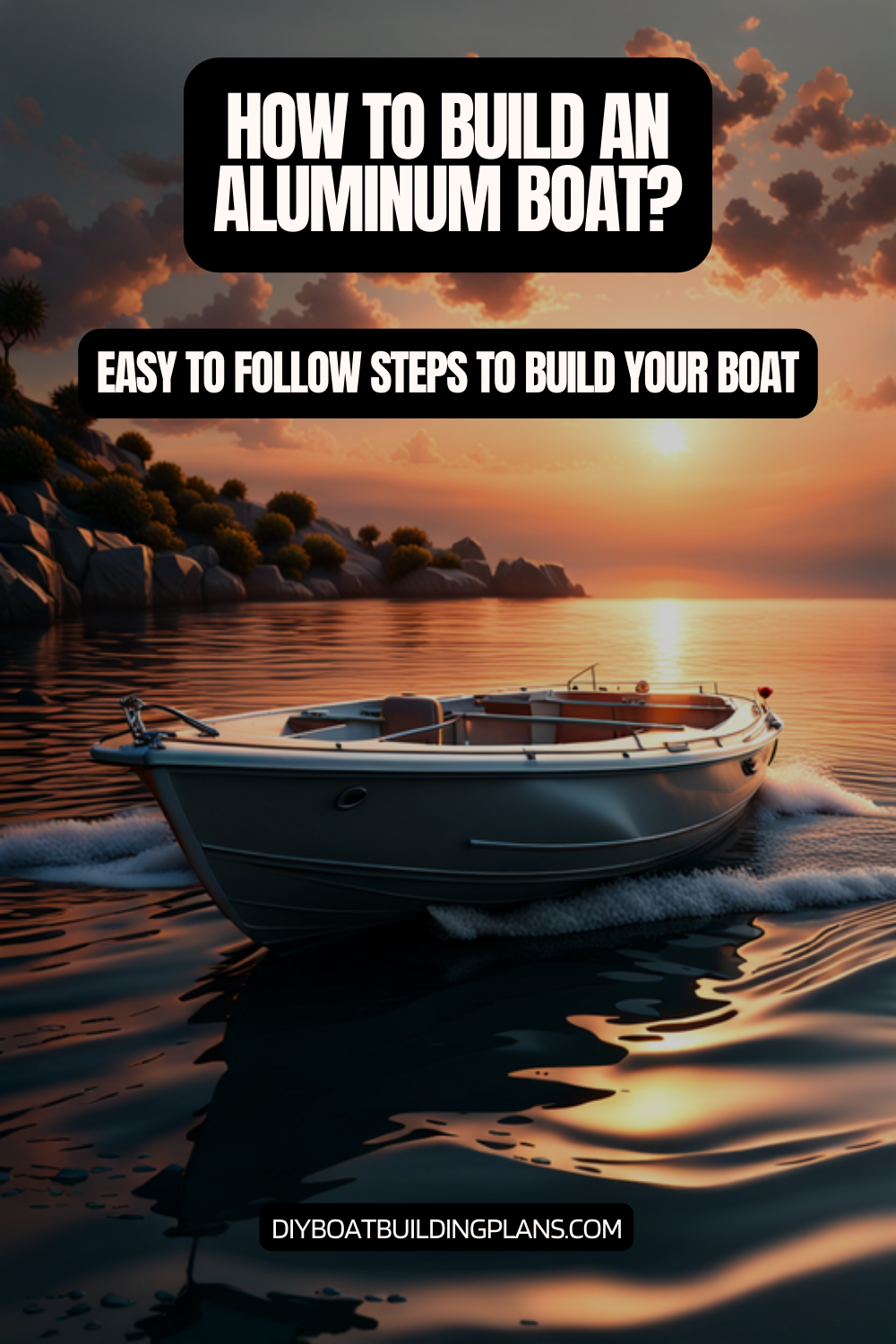Ever thought about turning aluminum sheets into a boat in your workshop? Building a DIY aluminum boat might seem hard, but it’s doable with the right skills. Making your own boat plans is a dream that can come true.
Creating an aluminum boat needs focus, patience, and a smart plan. Experts like Rick Wellins show that with clever design and building, amazing boats can be made. The process includes picking the right aluminum, learning to weld, and knowing how to build it strong.
Choosing the right materials and setting up a strong jig are key steps. This guide will help you build a custom aluminum boat that’s top-notch.
Key Takeaways – How To Build an Aluminum Boat at Home
- DIY aluminum boatbuilding requires specialized skills and equipment
- Selecting the correct aluminum grade is key for durability
- Proper welding is vital for a strong boat
- Research and planning are essential for success
- Safety and precision are critical during building

Essential Materials and Tools for Aluminum Boat Construction
Building an aluminum boat needs careful material and tool selection. The right materials and tools are key to success. They can make your project shine or fall short.
Selecting the Right Grade of Aluminum
Marine-grade aluminum is essential for boat building. Grades 5086 and 5083 are top choices. They have:
- High magnesium for strength
- Great corrosion resistance
- Easy workability for hulls
Required Tools and Equipment
Specialized tools are needed for aluminum welding. Key items include:
- Pulse MIG welder with spool gun
- Precision cutters (laser or waterjet)
- Hand tools for details
- Measuring and marking tools
| Tool Category | Recommended Equipment | Purpose |
|---|---|---|
| Cutting Tools | Plasma cutter | Precise aluminum panel cutting |
| Welding Equipment | TIG welder | Riveting aluminum boats |
| Measurement | Digital calipers | Ensuring precise dimensions |
Safety Equipment Checklist
Safety is critical in boat building. Essential gear includes:
- Welding helmet with proper shade rating
- Flame-resistant gloves
- Respiratory protection
- Safety glasses
- Ear protection
“Proper preparation prevents poor performance in boat building.” – Professional Boat Constructor
Quality materials and tools are vital for a safe and successful boat project.
Understanding Aluminum Boat Design Plans
Building a homemade aluminum boat needs good design plans. You must plan carefully and know the technical details. These details affect how well your boat will perform and last.
When looking at homemade aluminum boat plans, there are key things to think about:
- Hull geometry and shape
- Material specifications
- Structural integrity requirements
- Performance characteristics
“A well-designed boat begins with meticulous planning and precision engineering.” – Marine Design Expert
Professional plans for aluminum boats include detailed measurements and how to put it together. The 6082 T651 profile is often chosen because it’s strong and doesn’t rust easily.
| Design Specification | Recommended Value |
|---|---|
| Hull Deadrise Angle | 22 degrees |
| Material Weight Advantage | 25% lighter than fiberglass |
| Estimated Material Cost | Under $30,000 |
Important in aluminum boat design are its thermal properties. Marine-grade aluminum melts at 658°C and conducts heat well. Its linear expansion is twice that of steel, affecting welding and structure.
Choosing the right design plan means knowing what you need from your boat. Look at different plans and talk to marine designers. This way, your homemade aluminum boat will be safe and perform well.
Unlock the secrets to building your dream boat with MyBoatPlans! With detailed plans for over 518 boats and expert video tutorials, you’ll have everything you need to create your perfect vessel. Click here to begin your journey!”
Preparing Your Workspace for Boat Construction
Building a DIY aluminum boat needs a well-prepared workspace. The right setup is key for a successful project. Your workspace will be where your boat comes to life, needing careful planning and organization.
Professional builders know a good workspace is vital. It can make your boat-building journey fun and rewarding.
Workshop Setup Requirements
- Minimum workspace dimensions of 20×30 feet
- Level concrete or solid flooring
- Overhead lighting for detailed work
- Electrical outlets near work areas
- Sturdy workbenches and sawhorses
Ventilation and Safety Considerations
Good ventilation is a must during boat construction. Use industrial fans and ensure air flows well. Always wear protective gear like welding masks and gloves to stay safe.
“Safety isn’t expensive, it’s priceless” – Unknown
Storage Space Planning
Good storage is key for organized boat building. Consider:
- Vertical tool racks
- Sealed metal cabinets
- Shelving units for materials
- Protected areas for aluminum sheets
Remember: A tidy workspace means smoother construction and better results.
How To Build an Aluminum Boat at Home
Building a DIY aluminum boat needs careful planning and precise work. Your journey begins with understanding the key steps and setting up your workspace well.
First, gather all the tools and equipment you’ll need. Here’s a list of what you should have:
- Millermatic 210 Welder
- Miller 3035 Spool Gun
- Angle grinders
- Circular saw
- Drill and impact driver
- Measuring tools (tapes, squares, levels)
Safety is very important in DIY aluminum boatbuilding. Make sure to get good personal protection gear:
- Respirator with replaceable filters
- Safety glasses
- Welding helmet
- Insulated welding gloves
- Ear protection
“Proper preparation prevents poor performance in boat construction.” – Experienced Boat Builder
Choose marine-grade aluminum for your boat. 5086 or 5083 aluminum grades are best for their durability and strength. These grades help your boat last in the marine environment.
| Aluminum Grade | Best Used For | Strength Rating |
|---|---|---|
| 5086 | Marine Hulls | High Corrosion Resistance |
| 5083 | Boat Structural Components | Excellent Weldability |
Practice backstep welding on scrap metal to get better. Also, think about the transom height for your motor. This ensures your boat works well and doesn’t get damaged.
Setting Up the Building Jig
Building a precise jig is key in making a homemade aluminum boat. The jig’s accuracy is the foundation of your boat’s structure. It ensures symmetry and strength in the construction process.
Jig Construction Methods
There are several ways to build a reliable jig for aluminum boats. The most common include:
- Custom-built sawhorses with adjustable height
- Ground-mounted frame with leveling capability
- Trailer-based platform for mobility
Leveling and Alignment Techniques
Getting your jig set up right is essential. Laser levels and professional measuring tools help achieve perfect alignment. Here are some important techniques:
- Use a laser level for accurate horizontal alignment
- Cross-square the jig to ensure geometric precision
- Check multiple points with digital measuring tools
Securing the Framework
Stability is key in aluminum boat building. Anchoring your jig prevents movement during welding and assembly. Some builders tack weld components to the jig for better control.
| Jig Material | Recommended Use | Stability Rating |
|---|---|---|
| Steel Tubing | Heavy-duty construction | Excellent |
| Aluminum Framing | Lightweight projects | Good |
| Wooden Frames | Budget-friendly options | Fair |
“A well-built jig is the blueprint of a successful boat build.” – Professional Boat Builder
Spending time on a solid and accurate jig is worth it. It ensures a quality finish on your homemade aluminum boat.
Cutting and Forming Aluminum Panels
When making aluminum boat parts, picking the right cutting method is key. DIY boat building means knowing how to cut panels accurately. This ensures your boat is built right.
- Laser Cutting: Very precise but only works on small tables
- Waterjet Cutting: Needs special edge care
- CNC Router: Big tables and detailed cuts
Boat-grade aluminum sheets start at 0.125 inches (1/8 inch). Thicker ones are called plates. The 5000 and 6000 series alloys are best for welding.
“Practice cutting techniques on scrap material before working on final boat panels” – Professional Boat Builder’s Tip
| Cutting Method | Advantages | Limitations |
|---|---|---|
| Laser Cutting | High precision | Small table size |
| Waterjet Cutting | No heat distortion | Edge preparation needed |
| CNC Router | Large cutting area | Complex detailed cuts challenging |
For tricky shapes like handrails, get help from pros. Cutting and shaping aluminum takes time and effort.
Welding Techniques for Aluminum Boats
Welding aluminum for boats needs precision and the right tools. Learning to weld at home is key for a strong boat.
Choosing the Right Welding Equipment
Choosing the right welding gear is key for building a boat. Experts say to use:
- MIG welder with pulse functionality
- Spool gun attachment
- Marine-grade aluminum filler materials (5356 and 4043)
Proper Welding Sequences
Good welding for aluminum boats needs a plan. Short welds help control heat and avoid damage.
- Clean the aluminum well
- Preheat it a bit
- Keep your speed steady
- Use push welding
Common Welding Mistakes to Avoid
Knowing common mistakes can help you weld better:
| Mistake | Consequence | Prevention |
|---|---|---|
| Overheating | Material warping | Control heat input |
| Contaminated surface | Weak welds | Thorough cleaning |
| Inconsistent technique | Structural weakness | Practice and steady motion |
Remember, practice on scrap aluminum before working on your boat’s critical components.
Installing the Transom and Hull Reinforcements
Building an aluminum boat needs careful work on the transom and hull reinforcements. These parts are key to your boat’s strength and how well it lasts.
The transom connects your boat’s hull to the outboard motor. It’s important to get it right. You need to:
- Determine the exact motor mounting height
- Select appropriate reinforcement materials
- Ensure proper alignment and structural support
Choosing the right aluminum alloy is key. Look at these material properties:
Download over 500 Boat Plans. Click on the link below.
-->Click Here<--
| Aluminum Alloy | Ultimate Tensile Strength | Yield Strength | Density |
|---|---|---|---|
| 5052 H32 | 33,400 psi | 28,300 psi | 0.0968 lb/in³ |
| 5086 H116 | 42,100 psi | 29,700 psi | 0.0961 lb/in³ |
“A well-constructed transom is the heart of any reliable boat design.” – Marine Engineering Expert
When reinforcing the hull, focus on high-stress areas like the chine and keel. Here’s how to do it right:
- Carefully align reinforcement brackets
- Use appropriate welding techniques
- Apply marine-grade sealants
- Verify structural integrity through careful inspection
Building an aluminum boat yourself takes time and attention to detail. The cost for materials can be around $4,454. With good planning and the right materials, you can succeed.
Adding Interior Components and Features
Building the inside of your homemade aluminum boat needs careful planning. The right parts can turn your boat into a great fishing spot that fits your needs.
When making your aluminum boat plans, think about these important interior parts:
Seating and Storage Solutions
Choosing the right seats and storage is key. For a 14′ boat for two, consider these options:
- Install two main seats that can move around
- Make built-in storage spots
- Design big deck storage doors (58″ long, 12″ wide)
Navigation Equipment Installation
Putting navigation tools in the right spots makes boating better. Key things to install are:
- A cell phone holder (about $100)
- USB charging ports ($20)
- A fish finder with a new transducer
Flooring and Finishing Details
Finish your boat’s inside with careful details:
| Component | Cost | Installation Difficulty |
|---|---|---|
| Rod Holders | $20-$50 | Easy |
| Cup Holders | $10-$30 | Very Easy |
| Rear-View Mirror | Under $100 | Simple |
When finishing your aluminum boat, use a cold galvanizing compound as primer. Also, think about a custom paint job to make your boat unique.
“The perfect boat is not just built, it’s carefully crafted with attention to every detail.” – Experienced Boat Builder
Waterproofing and Sealing Techniques
Building an aluminum boat at home means you must waterproof it well. This step is key to keeping your boat safe and working right. Sealing is very important to stop water from getting in and causing harm.
Choosing the right sealant is very important. Marine-grade sealants help keep your boat dry and strong. Two great products for sealing aluminum boats are:
- 5200 Marine Fast Cure
- Amazing GOOP Marine
“It is better to over-seal than under-seal when applying sealant to ensure optimal protection.” – Boat Building Expert
Focus on these areas for waterproofing:
- Seams and rivets (primary leak points)
- Hull connections
- Fittings and penetrations
- Welded joints
To seal your aluminum boat, follow these steps:
- Clean surfaces well
- Make sure they are dry before you start
- Use a lot of sealant
- Wait for it to dry completely
Wetlander boat coatings add extra protection. They stick well to aluminum and sealants. Builders say to check your work many times to make sure it’s tight.
Pro tip for How To Build an Aluminum Boat at Home: Spend extra time on waterproofing. A little extra effort in sealing can save you a lot of trouble and make your boat last longer.
Final Inspection and Water Testing
Finishing your DIY aluminum boat project needs a careful final check. This ensures your boat is safe and works well. The water test is key to making sure your boat is strong.
“A thorough inspection can prevent 90% of possible maritime mishaps” – Marine Safety Expert
Before you launch your aluminum boat, do a detailed check. Look at important parts:
- Check all welding seams for complete fusion
- Verify tight and secure fittings
- Inspect hull for any possible stress points
- Test all installed equipment functionality
Water testing gives you important info about your DIY aluminum boat. It shows that 50% of boat problems come from underwater parts. This makes the test very important.
Recommended Inspection Checklist
- Examine hull for watertightness
- Test navigation equipment
- Check structural integrity
- Verify waterline performance
Pro Tip: Consider a professional marine survey for an expert assessment of your custom-built aluminum boat.
Interestingly, some freshwater aluminum boats from the ’60s are working today. This shows that well-made boats can last a long time. Paying attention to details during the final check can help your boat last as long.
Things like electrolysis and corrosion can be avoided with careful checks. Make sure to inspect underwater parts well to avoid future problems.

Conclusion – How To Build an Aluminum Boat at Home
Building an aluminum boat at home is a thrilling journey in craftsmanship and engineering. It challenges you to master metalworking and create a boat that fits your needs. You’ll need patience, technical skills, and a willingness to learn.
Every step in building an aluminum boat is a chance to grow and learn. You’ll pick the right materials and learn to weld. This journey is rewarding, giving you a sense of pride and a personal connection to your boat.
Safety and careful planning are key when building a boat. You’ll need good tools, safety gear, and to follow design plans closely. Even with challenges, you’ll get better at solving problems and improving your skills. Your hard work will pay off with a boat that shows your dedication and creativity.
Building an aluminum boat is more than a DIY project; it’s a life-changing journey. You’ll gain new skills, own a custom boat, and feel proud of your creation. The memories and skills you gain will last a lifetime.
FAQ – How To Build an Aluminum Boat at Home
What Aluminum Grade is Best for Boat Building?
For building boats, 5086 or 5083 aluminum grades are top choices. They have magnesium, which boosts strength and fights corrosion. This makes them great for boat projects.
How Much Does It Cost to Build an Aluminum Boat at Home?
The cost depends on the boat’s size and design. It can range from $2,000 to $10,000. Prices are affected by materials, design, and extra features like motors.
What Tools Do I Need to Build an Aluminum Boat?
You’ll need a pulse MIG welder and tools for cutting aluminum. Also, measuring tools, a welding helmet, gloves, clamps, and hand tools are essential. A well-ventilated workspace is also important.
How Long Does It Take to Build an Aluminum Boat?
Building a boat can take 200-500 hours for a skilled DIYer. The time depends on the boat’s size and design. Beginners might need more time to learn.
Do I Need Professional Welding Experience?
Professional welding skills are helpful but not required. Practicing on scrap aluminum and taking a welding course can improve your skills. This will make your boat better.
Where Can I Find Boat Building Plans?
You can find plans on Metalboatkits.com, marine design websites, and boating forums. Professional companies also offer detailed plans for different boats.
What Safety Precautions Should I Take?
Wear proper welding gear and ensure good ventilation. Use eye protection and keep a fire extinguisher nearby. Follow safe welding and cutting practices.
Can I Customize the Boat Design?
Yes, you can modify many boat plans to fit your needs. But, it’s important to keep the boat safe and strong. Follow professional design tips.
What Maintenance Is Required for an Aluminum Boat?
Regular checks include inspecting welds and looking for corrosion. Apply marine sealants and clean the boat after use. Store it properly to avoid damage.
Is Building an Aluminum Boat Cheaper Than Buying?
DIY boat building can save money, but it’s not always cheaper. It requires time, tool costs, and might involve mistakes. The main benefit is a custom boat that meets your needs.



